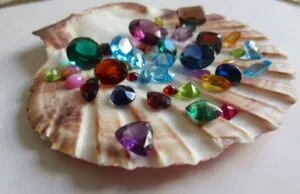
Table of Contents
Nose rings, now the second most popular body piercing after earrings, carry a rich history of aesthetic and symbolic significance across various cultures. Today, they’ve transcended traditional boundaries, becoming a mainstream fashion statement. The type of nose ring you choose is a reflection of your personality, ranging from elegant and exotic to bold and non-conforming.
If you’re considering joining this growing trend, our beginner’s guide covers all you need to know about choosing your first nose ring, helping you make a statement that’s uniquely yours.
Origin and History of Nose Piercings
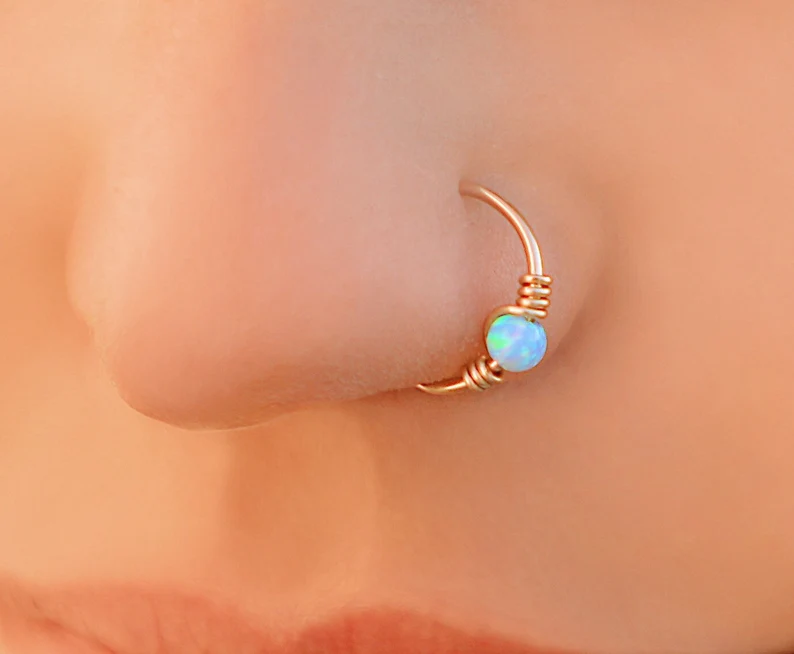
Nose piercings, dating back over 4,000 years in the Middle East, are among the oldest body modifications. They spread to India in the 16th century with the Mughal empires, becoming a cultural symbol often related to marital status and social class. In Indian tradition, piercing the left nostril, believed to ease childbirth and reduce menstrual pain, links to Ayurvedic practices.
Globally, various indigenous tribes and civilizations have also practiced nose piercing, each with their unique meanings and importance. For example, in some African and Australian Aboriginal cultures, nose piercings served as tribal rituals and status symbols.
In the Western world, nose piercing began as a rebellion symbol in the 1960s and 70s, tied to the hippie and punk rock movements. In recent decades, it has moved beyond rebellion to become a mainstream fashion trend.
Today, people of all ages and backgrounds wear nose piercings as a self-expression form, connecting with their cultural and spiritual roots, especially in cultures with a historical significance for nose piercing.
The increasing popularity of nose piercings in modern fashion mirrors a broader movement of embracing diverse beauty standards and accepting body modification as personal and cultural expression.
Different Types of Nose Piercings
There are at least 10 different types of nose piercings available to you, from novice to hard-core. Here’s a quick run down of the most popular.
1- Nostril Piercing
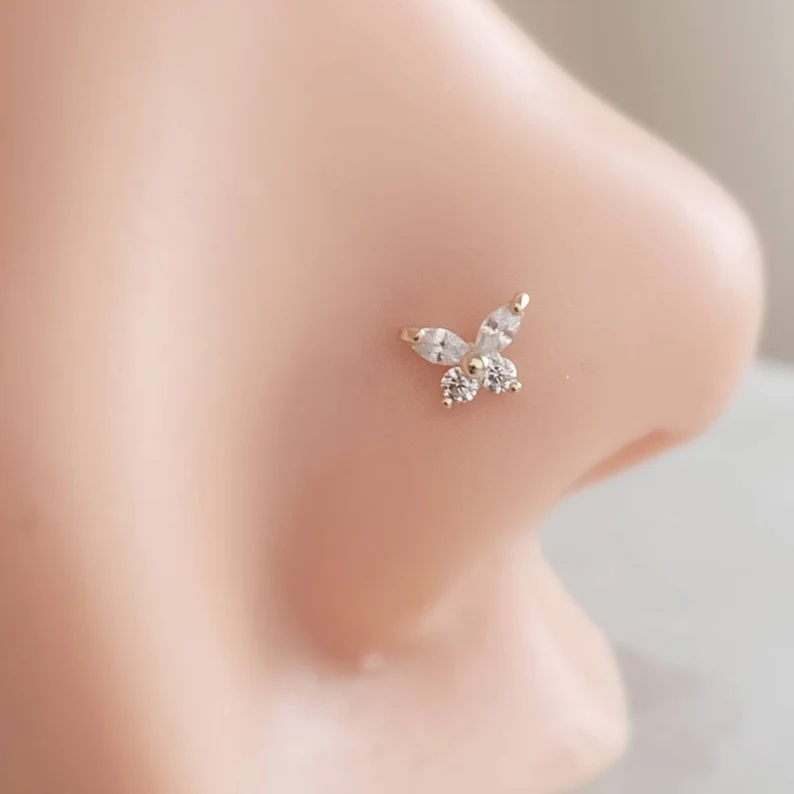
The most traditional and popular form of nose ring is the nostril piercing. Here, you can choose either the left or right nostril based on your preference. The commonly used type of jewelry with a nostril piercing is a stud or a nose ring. This is placed just at or above the groove of the nostril’s curve.
2- Septum
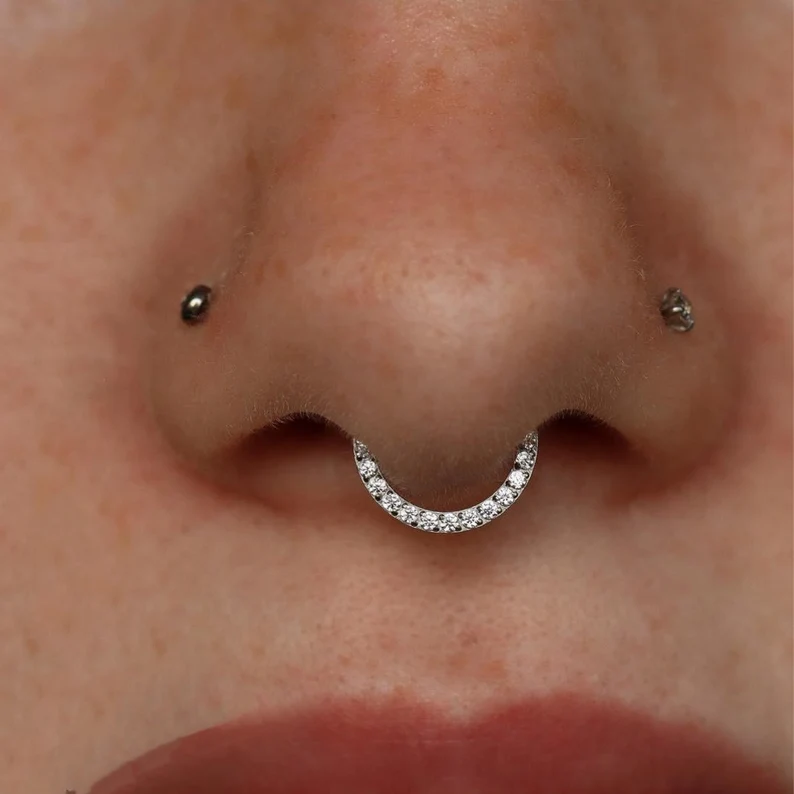
This is the most popular type of nose piercing at the moment because it’s versatile and stylish. The septum piercing is more complicated than a nostril piercing and needs to be performed by a skilled nose piercer. Usually, the piercer will choose the area where there is an absence of cartilage (such as the web os skin where the cartilage and the bottom of the nose meet) so ensure that your piercer knows his cartilage.
You can choose to go with a simple septum ring, circular barbells, captive bead rings or other elaborate designs. The circular barbell (also called horseshoe) is the most popular. If you have a barbell septum ring, you can easily flip it upwards to hide it, if need be.
3- High Nostril
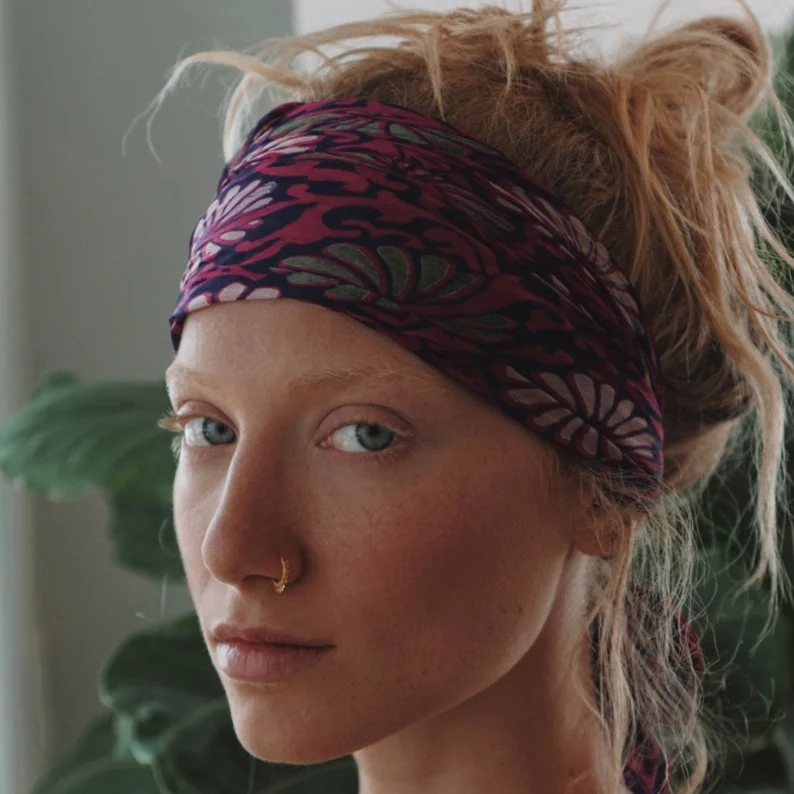
The high nostril is a variation of the nostril piercing. Here the nostril is pierced at its highest point, before the bridge of the nose begins. This is a unique and stylish spot for a piercing.
The high nostril is pierced in one of the thickest parts of the nose and is a hard to reach area, so piercing this spot can get complicated. Choose a skilful piercer for this one.
For a high nostril piercing, studs, nostril screws and L-shaped nose pins work best.
4- Bridge Piercing
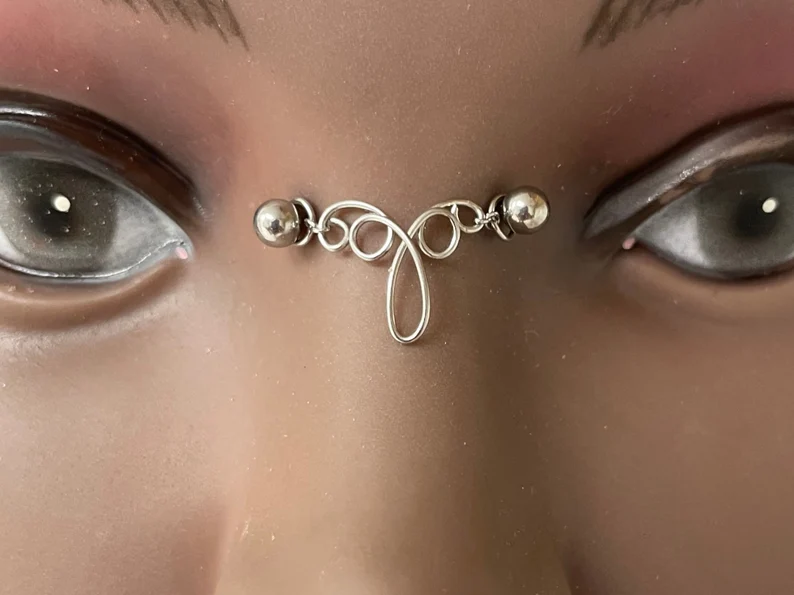
The Bridge Piercing, also known as the Erl, is done horizontally across the bridge of the nose, and is known as a surface piercing. What this means is that the cartilage or bone of the nose is not punctured.
However, as a surface piercing, the chances of the body rejecting the jewelry are higher. What the body does is to push the foreign body (in this case the jewelry) outwards towards the surface of the skin in an effort to heal. If this happens, it is best to remove the piercing and allow the hole to heal.
Curved and circular barbells are ideal for bridge piercings. It is not recommended to choose a straight barbell as the chance of the body’s rejection are higher.
5- Rhino Piercing / Vertical Tip
The rhino piercing, also known as the vertical tip piercing, is quite unique and rare. It almost always involves a curved barbell, that runs from the tip to the bottom of your nose. You can choose a straight bar but this can get more complicated.
6- Nasallang Piercing
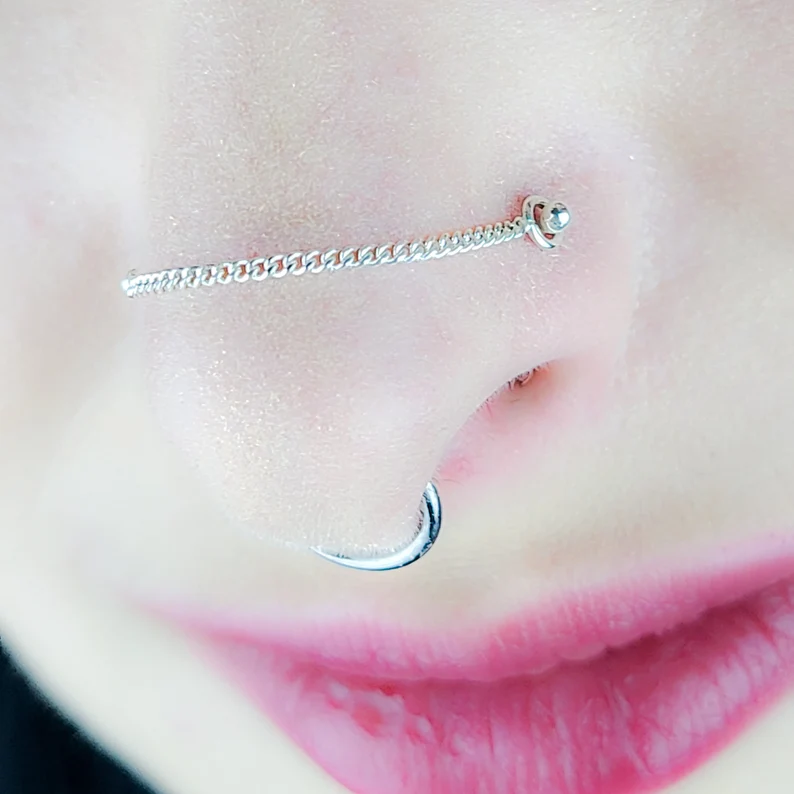
Possibly the most involved form of nose piercing, the nasallang passes through both nostrils and the septum. It may seem just like two simple nostril studs, but is actually quite complicated. It is usually done with one sterilized needle in one go, passing through the width of your nose. The nasallang requires symmetry and perfection to look its best, so ensure that your piercer is experienced.
7- Austin Bar
This piercing has the same concept as the nasallang, except that it does not pass through the septum. Instead, it is a nasal tip that pierces the fleshy point of your nose horizontally. This is quite a rare piercing and is named after the first known person to get the piercing.
Types of Nose Rings
Nose rings come in various types and styles, each with unique features catering to different preferences and comfort levels.
1. Stud Nose Rings
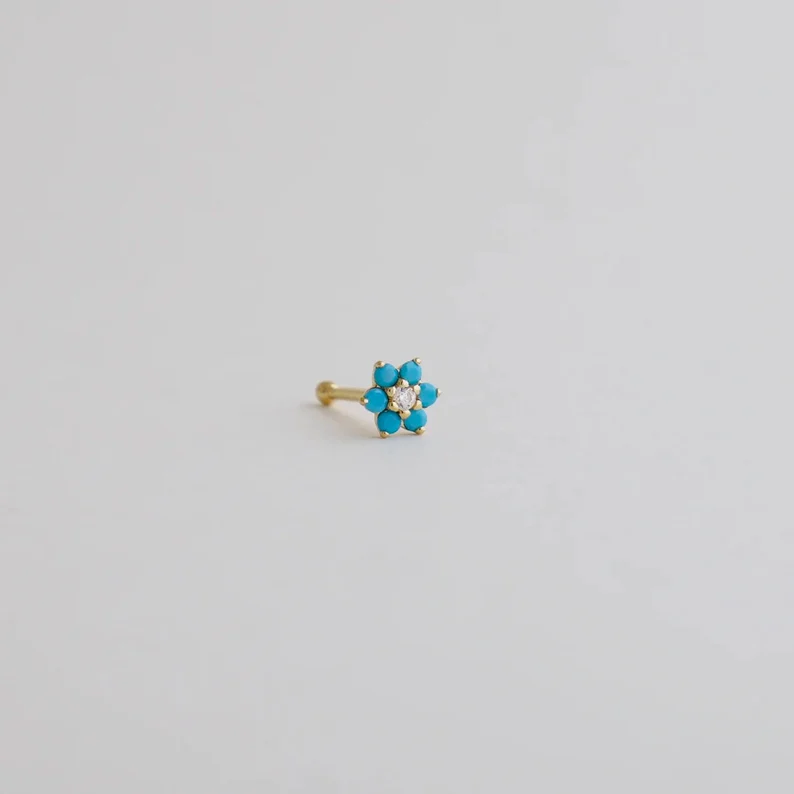
These popular and versatile rings have a straight post that goes through the piercing and stays in place with a small backing. Ranging from simple metal balls to detailed designs with gemstones or unique shapes, stud nose rings are great for a subtle, elegant look.
They fit well with a minimalist style but can also be eye-catching with more decorative designs. Suitable for daily wear and special events, stud nose rings suit many personal styles while keeping a sophisticated look.
2. Hoop Nose Rings
Also called nose hoops, these rings loop around the nostril for a noticeable and fashionable appearance. They come in many sizes, from small and subtle metal loops to larger hoops with gems or decorative elements.
This variety lets you decide how much you want your nose ring to stand out. Hoop nose rings are a classic choice that works with both traditional and bohemian styles, adding flair to any outfit.
3. L-Shaped Nose Rings
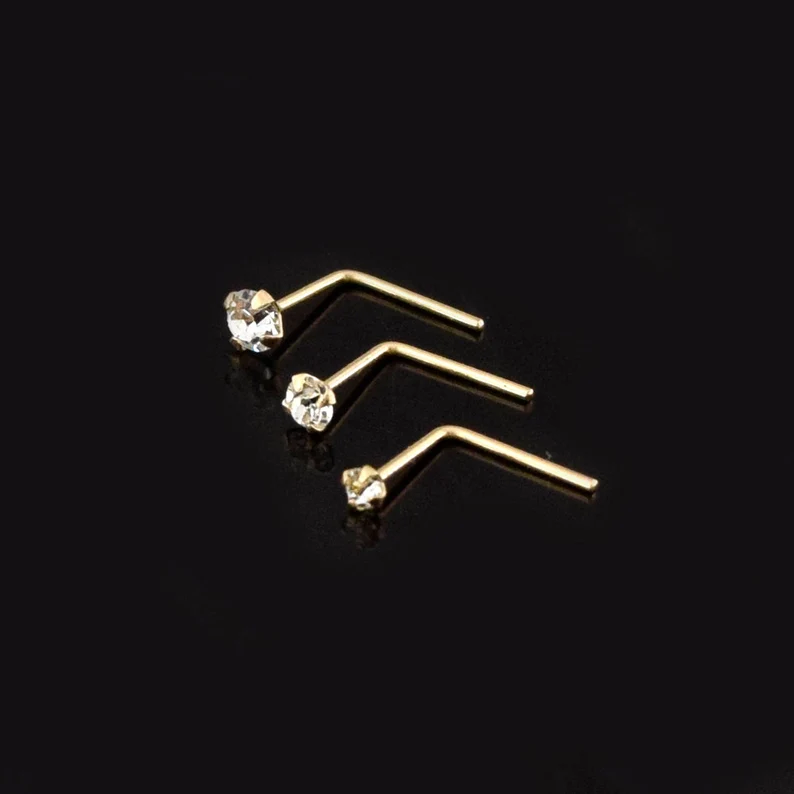
These rings have a short post that bends at a right angle, forming an ‘L’ shape. This design makes them easy to put in and ensures they stay secure. L-shaped nose rings are a good option if you like the simplicity of studs but want extra security.
They’re especially suitable for those new to nose piercings or people with active lifestyles who might worry about their ring coming loose.
4. Screw Nose Rings
With a post that coils like a corkscrew, these rings provide a secure fit. The screw part anchors the ring inside your nostril, reducing the chance of it getting loose or falling out. Screw nose rings are ideal for active people or those who want a secure nose ring. They come in various styles, from sleek and simple to ornate.
5. Septum Rings
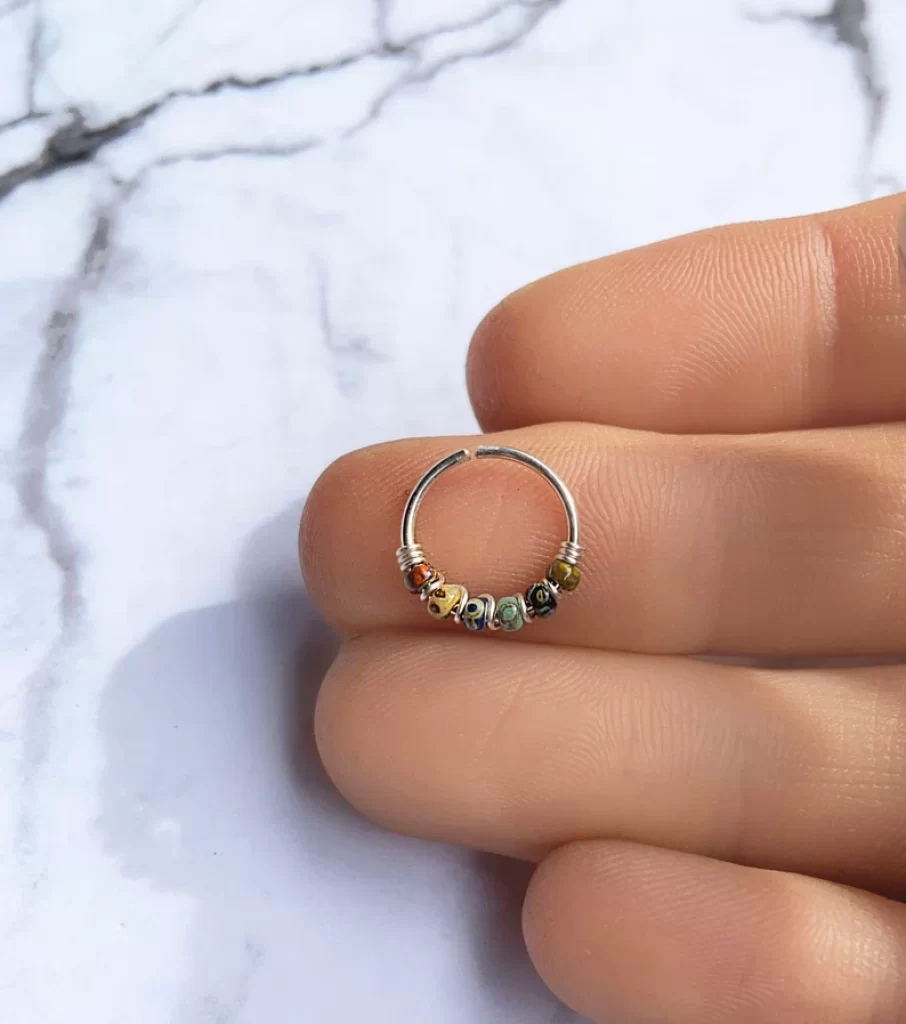
Worn in the septum, the cartilage between your nostrils, these rings range from small, discreet hoops to larger, decorative ones. Many include clickers with a hinged closure for easy use.
Septum rings have become popular for their bold, alternative look. They offer a range of styles, from subtle to eye-catching, catering to different fashion tastes.
6. Curved Barbells
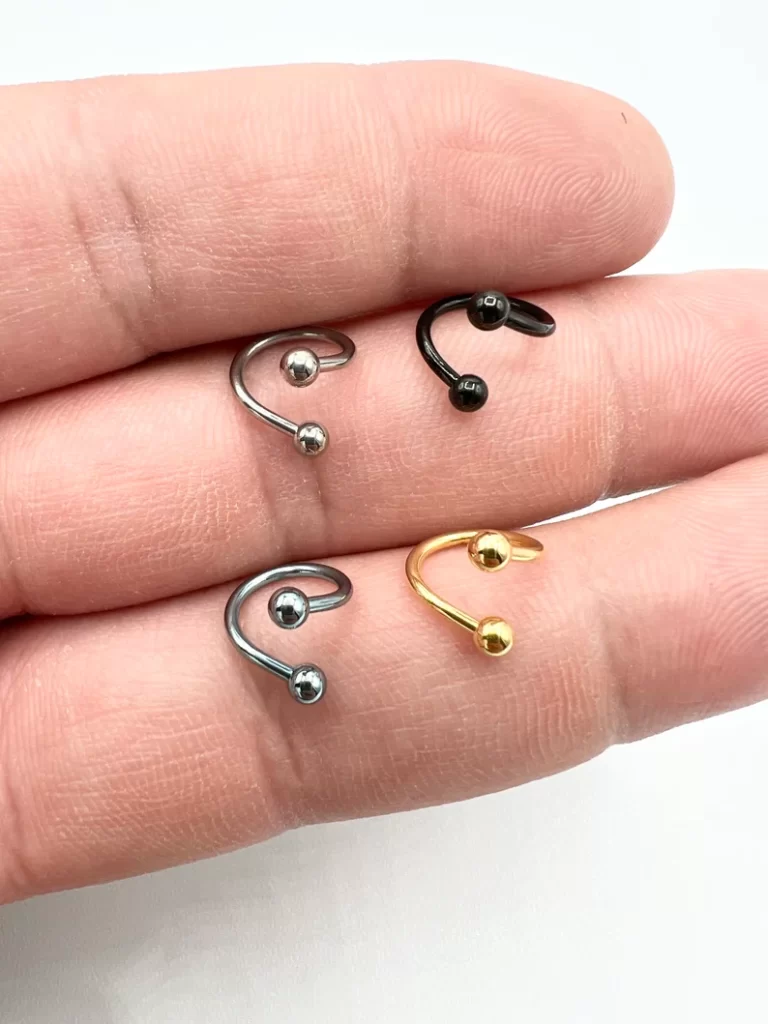
A curved barbell, also known as banana bars and bent barbells, is a variation of the ring. This is especially perfect for septum piercings and can be threaded through the hole by unscrewing the ball edges.
7. Captive or Fixed Bead Rings
A captive bead or fixed bead ring is a combination of the traditional ring and the barbell. These are very popular but can be somewhat complicated to remove.
What’s the Best Nose Ring to Start With?
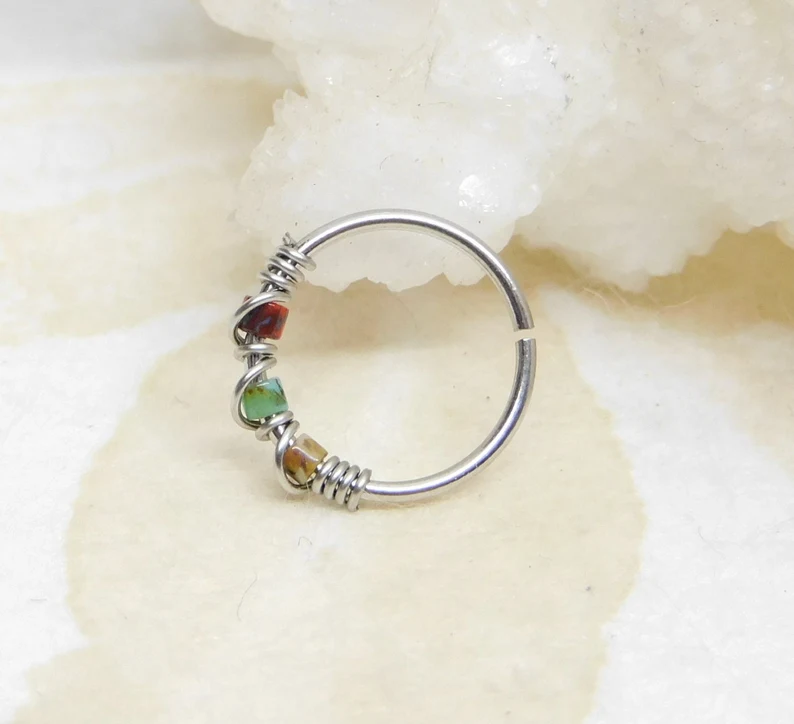
The best nose piercing to start with is the simple nostril piercing. This is less complicated and risky than some of the other types mentioned above and is not intimidating.
The best nose jewelry to start with is the nose ring. This allows you to clean the jewelry as you can turn it to clean all surfaces. It also has room to accommodate any swelling. However, the very fact that it can fully rotate means that bacteria from the outer part of the ring can get to your unhealed skin if you change its position.
If you don’t want your nose ring to be too attention-grabbing at the start, choose a ring with a higher gauge, such as 24 or 26 gauge.
Once you see how you feel about wearing a nose ring, and as you get more confident and comfortable, perhaps you might be interested in taking it up a notch. You can do this by choosing bigger or more interesting types of nostril jewelry, having multiple nostril piercings for layering or trying one of the other more involved types of piercings.
What Materials are Used for Nose Rings?
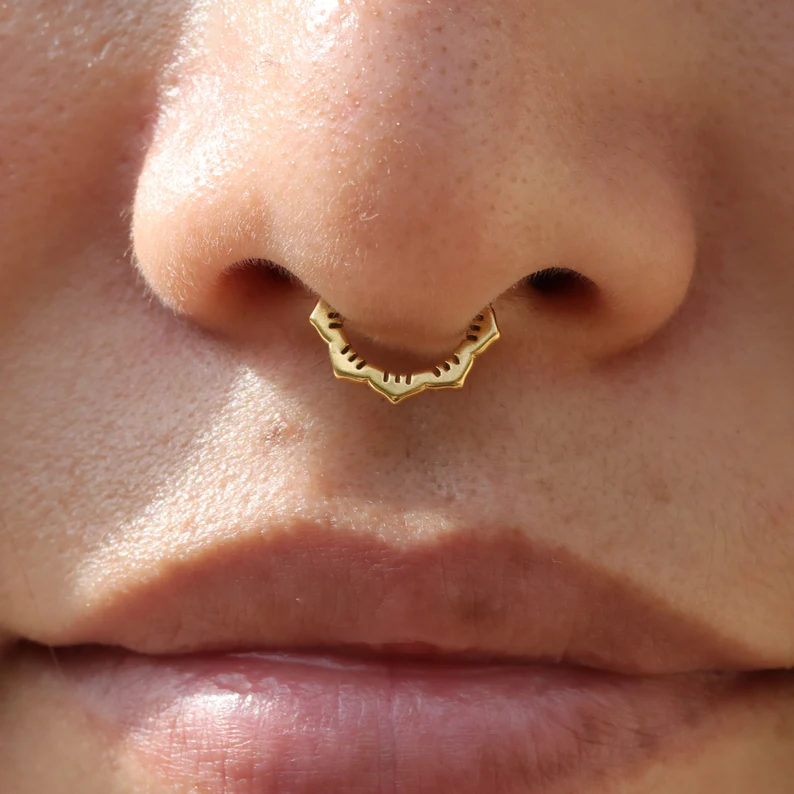
When you’re picking out a nose ring, the material is really important, especially if you have sensitive skin or allergies. The most common materials for nose rings are surgical steel, titanium, gold, and biocompatible plastics, and each has its own benefits.
Surgical Steel is a favorite because it’s strong and doesn’t cost much. It’s made from a mix that includes chromium, nickel, and molybdenum, which helps it resist rust and tarnishing. But, keep in mind, it often contains nickel, which can cause allergic reactions for some people.
Titanium is a great choice for those with skin sensitivities. It’s light, super strong, and most importantly, hypoallergenic, meaning it’s unlikely to cause any allergic reactions. Titanium nose rings also come in different colors, which adds to your style choices without risking your skin’s health.
Gold Nose Rings, usually in 14k or 18k, are both classic and hypoallergenic, making them perfect for a fancy look. Gold doesn’t react much with your skin, so it’s a good pick for those with allergies. Just make sure the gold is high-quality and not mixed with nickel or other irritating metals.
Biocompatible Plastics, like bioflex or PTFE, are getting more popular for nose rings. They’re bendy, light, and don’t usually irritate your skin. They’re especially good for new piercings because they’re comfy and can help reduce healing time.
Choosing a hypoallergenic material for your nose ring is key to avoid skin irritation, especially if you’re getting a new piercing or have sensitive skin. Always go for high-quality materials from trusted sellers and get advice from a professional piercer when you’re unsure. The right material will not only be comfortable but also help prevent allergic reactions and make your nose ring last longer and look better.
Nose Ring Gauges and Sizing
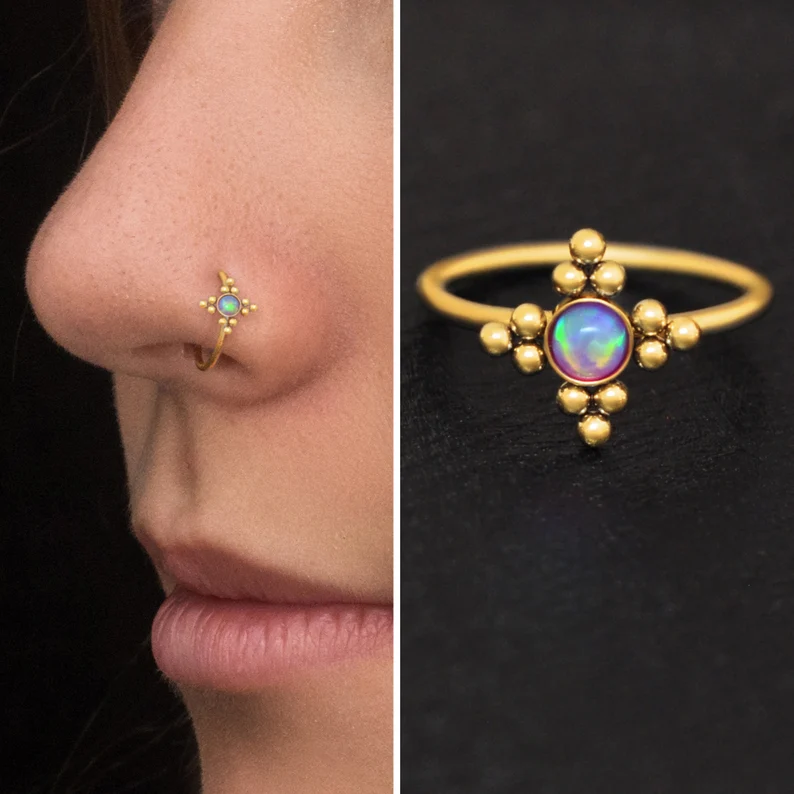
In piercing terminology, “gauge” refers to the thickness of the jewelry. It’s important to know that a lower gauge number means thicker jewelry. For example, a 20-gauge nose ring is thinner than an 18-gauge one.
Most nose piercings use 20 or 18 gauge needles, making these the common sizes for nose rings. Your choice between these sizes should depend on your personal style preference. A 20-gauge ring looks more delicate, while an 18-gauge offers a slightly bolder appearance and might feel sturdier.
It’s essential to choose a nose ring gauge that matches your piercing size. If you pick a gauge that’s too thin, your piercing hole might shrink, making it harder to fit thicker jewelry later. On the other hand, a too-thick gauge can be uncomfortable and might even harm your piercing.
If you’re not sure about your piercing’s gauge, ask a professional piercer for help. They can measure your piercing and suggest the right jewelry gauge. Also, keeping a consistent gauge size is important when you change or upgrade your nose ring to ensure comfort and keep your piercing healthy.
How to Choose the Right Nose Ring Style for You
When choosing a nose ring, think about your personal style and how you want the nose ring to complement it. If you prefer a subtle or professional look, go for a small stud or a simple hoop.
These are low-key enough for most workplaces but still let you show your style. If you like a bolder or more edgy style, consider larger hoops, decorative studs, or septum rings for a stronger statement.
Your facial features are also important in this decision. If you have a smaller nose, smaller and finer jewelry will fit better without being too much. But if you have a larger nose, you can go for bigger or more ornate nose rings. Also, the type of nose ring should match where your piercing is. A ring that works for a nostril piercing might not suit a septum piercing.
Finally, think about the color of the metal and how it matches your skin tone. Gold works well with warm skin tones, while silver and platinum are better for cooler tones. Choosing the right nose ring is about balancing your personal style with what looks good on you and fits your lifestyle.
Health and Safety When Using Nose Rings

When it comes to nose piercings, health and safety should always come first. It’s crucial to choose high-quality nose rings to avoid infections and allergies. Pick hypoallergenic materials like surgical steel, titanium, or gold for your nose rings, as they’re less likely to irritate.
Stay away from cheap metals that can cause infections or allergic reactions. Aftercare for new piercings is also vital. Regularly clean your piercing with a saline solution or an antiseptic your piercer recommends. Don’t touch the piercing with dirty hands, and avoid moving or twisting the jewelry too much; this can irritate the piercing and slow down healing.
Always keep the pierced area clean and dry, particularly after showering or exercising. Watch out for signs of infection, like redness, swelling, or discharge, and see a professional if you notice these. Good aftercare and choosing the right jewelry are important for your nose piercing’s proper healing and overall health.
How to Take Care of Your Nose Ring
To change and maintain nose rings safely, make sure the piercing is fully healed, which usually takes 4 to 6 months. Always use clean hands when handling your nose ring to prevent bacteria. Change the ring gently to avoid irritating the piercing.
Regularly clean both the nose ring and piercing with a saline solution or mild, unscented soap, avoiding harsh or alcohol-based products that can irritate the skin. Frequently check and tighten any screw-on backs or clasps to keep the nose ring secure. Proper care and gentle handling will help maintain your nose ring and piercing.
Where to Buy Nose Rings
- Etsy is ideal for unique, handcrafted nose rings, offering a range of artisanal and custom-made designs from independent creators. It’s perfect for those seeking something personalized or supporting small businesses.
- Amazon, on the other hand, provides a vast selection from various brands, suitable for quick, convenient shopping. With a wide range of styles and prices, along with customer reviews, Amazon is great for those who want to compare options and find something quickly.
Wrapping Up
Nose rings go beyond just being fashion pieces; they represent cultural heritage, personal expression, and contemporary style. Whether you choose a simple stud, a classic hoop, or an eye-catching septum ring, the right nose ring can really bring out your personal style.
There’s a nose ring for everyone, with plenty of materials and designs to choose from. To truly enjoy your nose ring, pick the right type and material, and take proper care of it.







